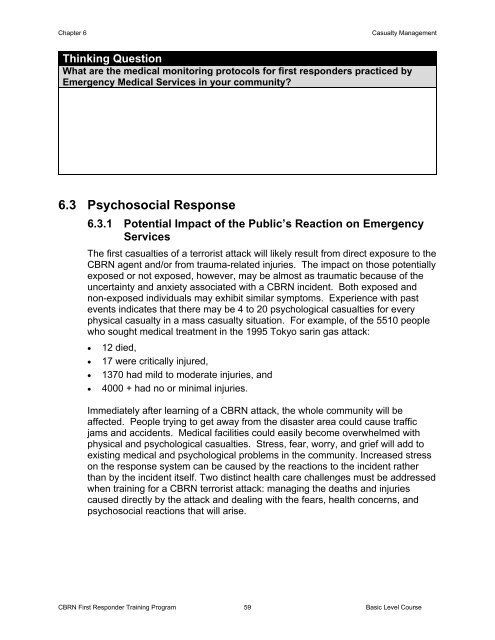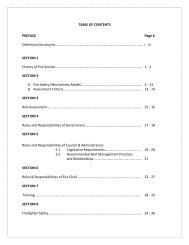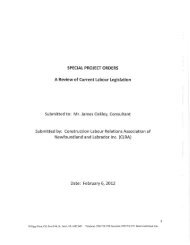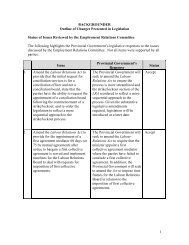Basic Level Pre-Course Reading
Basic Level Pre-Course Reading
Basic Level Pre-Course Reading
Create successful ePaper yourself
Turn your PDF publications into a flip-book with our unique Google optimized e-Paper software.
Chapter 6<br />
Casualty Management<br />
Thinking Question<br />
What are the medical monitoring protocols for first responders practiced by<br />
Emergency Medical Services in your community?<br />
6.3 Psychosocial Response<br />
6.3.1 Potential Impact of the Public’s Reaction on Emergency<br />
Services<br />
The first casualties of a terrorist attack will likely result from direct exposure to the<br />
CBRN agent and/or from trauma-related injuries. The impact on those potentially<br />
exposed or not exposed, however, may be almost as traumatic because of the<br />
uncertainty and anxiety associated with a CBRN incident. Both exposed and<br />
non-exposed individuals may exhibit similar symptoms. Experience with past<br />
events indicates that there may be 4 to 20 psychological casualties for every<br />
physical casualty in a mass casualty situation. For example, of the 5510 people<br />
who sought medical treatment in the 1995 Tokyo sarin gas attack:<br />
• 12 died,<br />
• 17 were critically injured,<br />
• 1370 had mild to moderate injuries, and<br />
• 4000 + had no or minimal injuries.<br />
Immediately after learning of a CBRN attack, the whole community will be<br />
affected. People trying to get away from the disaster area could cause traffic<br />
jams and accidents. Medical facilities could easily become overwhelmed with<br />
physical and psychological casualties. Stress, fear, worry, and grief will add to<br />
existing medical and psychological problems in the community. Increased stress<br />
on the response system can be caused by the reactions to the incident rather<br />
than by the incident itself. Two distinct health care challenges must be addressed<br />
when training for a CBRN terrorist attack: managing the deaths and injuries<br />
caused directly by the attack and dealing with the fears, health concerns, and<br />
psychosocial reactions that will arise.<br />
CBRN First Responder Training Program<br />
59<br />
<strong>Basic</strong> <strong>Level</strong> <strong>Course</strong>

















